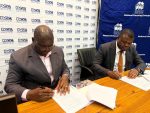Namibia possesses the capacity to replicate Guyana’s achievements in the energy industry, according to NJ Ayuk, the African Energy Chamber’s chairman.
Ayuk lauded the abundant geological resources of both nations in a recent discussion with Paul Hickin, editor-in-chief of Petroleum Economist. However, he emphasised the criticality of fiscal and regulatory frameworks to facilitate the conversion of resources into production.
“Having oil is not enough. The ability to have the right kind of regulatory and fiscal frameworks is crucial,” Ayuk stated. He highlighted Guyana’s roadmap, noting, “They discovered around 2015. They kept the fiscals in check. They worked collaboratively with energy companies, with ExxonMobil.”
He said that Namibia now has the opportunity to show the world “what energy can do.”
Ayuk’s sentiments mirror those made by TotalEnergies recently in which the company also noted that Namibia’s oil potential could one day match Guyana, where big discoveries have sparked an economic transformation and set the world’s biggest companies jostling for position.
There’s a “big chunk of oil” in waters off Namibia, said Patrick Pouyanne, chief executive officer of TotalEnergies SE, which alongside several other companies has made significant discoveries in the African country.
“Shell has some oil, we have some oil, Galp has some oil,” Pouyanne said in an interview at the French company’s headquarters near Paris last month. A scenario “like you have today in Guyana is very possible.”
Current production numbers offshore Guyana are over 600,000 barrels per day (b/d) from Exxon’s three Stabroek Block projects. Guyana is on track to push its combined production to 1.3 million b/d by 2027.
Ayuk emphasised the significance of establishing a stable environment for rapid production, ensuring contract sanctity, and implementing effective fiscal and local content policies. He stated, “It starts with getting local content right. It starts with getting those fiscals right. It starts with looking at the sanctity of contracts and the production climate.”
Ayuk is confident in Namibia’s potential, saying, “There is still a lot more hydrocarbons to be found in Namibia.” He urged the country to follow Guyana’s example to harness its energy resources effectively.
Guyana and Namibia have similarities in their oil exploration paths. Guyana’s resources are estimated at more than 11 billion oil-equivalent barrels. Guyana’s is the accumulation of more than 30 discoveries in the Stabroek Block alone.
Namibia’s discoveries were estimated to be the same up to August last year, by the National Petroleum Corporation of Namibia (NAMCOR). The estimate was spread over three finds, with TotalEnergies’ Venus-1X discovery accounting for nearly half. The Graff-X1 and Venus-X1 Namibia finds, according to Westwood Global Energy Group, share similarities with the Guyana-Suriname Basin. However, additional exploration success by Galp Energia, announced in January, could place the estimate higher.
The Latin American nation became the world’s fastest growing economy after Exxon Mobil Corp. tapped large offshore discoveries there. Earlier this month, the U.S. company formally approved its sixth oil development in Guyana, which will one day make it a bigger crude producer than its neighbor and founding OPEC member Venezuela.
Guyana and Namibia are expected to be pivotal exploration hotspots in the coming years.
Officials from Namibia’s Ministry of Mines and Energy and state oil company Namcor visited Guyana late last year seeking advice about oil developments, including the participation of local business, raising public awareness and expanding port facilities.
There were a lot of problems experienced with infrastructure in Guyana “and the advice Namibia got was to take our time and do proper infrastructure assessment,” Maggy Shino, Namibia’s petroleum commissioner, was quoted saying recently.










